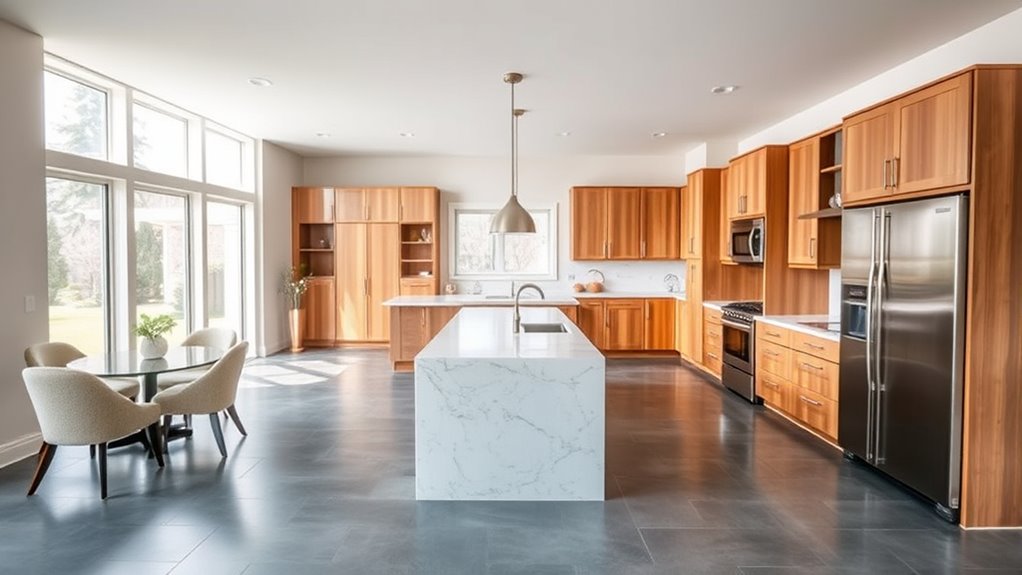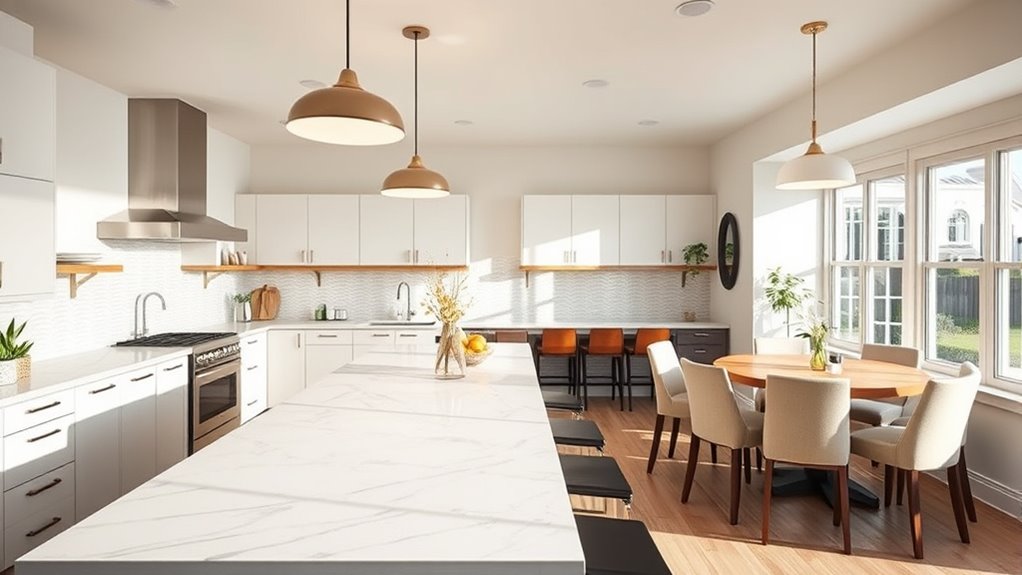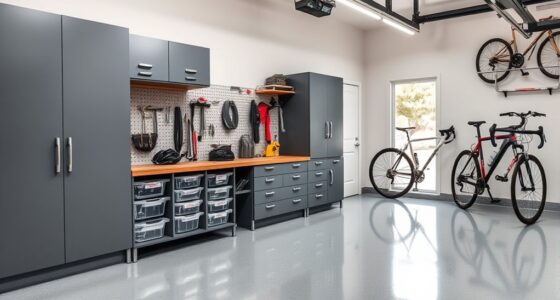To improve flow in an open-concept kitchen, you should define distinct zones that work seamlessly together. Use design techniques like cabinetry, lighting, and layout to create visual boundaries without walls, ensuring each area remains functional. Incorporate appliances thoughtfully into cabinetry to reduce clutter and maintain sleekness. Layer the lighting to support different activities and highlight features, enhancing both beauty and usability. Keep exploring this approach to master a cohesive, inviting space.
Key Takeaways
- Define distinct zones through layout and design elements without physical walls for seamless flow.
- Incorporate built-in appliances and cabinetry to maintain a sleek, clutter-free environment.
- Use layered lighting—ambient, task, and accent—to enhance functionality and ambiance within each zone.
- Position appliances strategically to minimize visual clutter and support easy movement during meal prep.
- Ensure clear pathways and logical placement of zones to facilitate smooth transitions and efficient workflow.

Have you ever wondered how to create a functional yet stylish open-concept kitchen? The key lies in planning distinct zones that work together seamlessly, guaranteeing your space feels inviting and efficient. One essential step is integrating appliances smoothly into your design. Instead of cluttering countertops with bulky toasters, mixers, or coffee makers, consider built-in options that blend into cabinetry or hidden compartments. This approach keeps your kitchen looking sleek and organized while maintaining easy access to what you need. For example, installing a built-in microwave or integrating the refrigerator into cabinetry creates a cohesive look. When appliances are thoughtfully incorporated, they don’t interrupt the flow or visual harmony of your open space. It also makes cleaning and maintenance simpler since everything is purposefully placed and streamlined. Additionally, implementing robotics technology in smart appliances can further enhance convenience and efficiency in your kitchen.
Alongside integrating appliances, zone lighting plays a vital role in defining and enhancing each area within your open-concept layout. Proper lighting helps establish visual boundaries without walls, making each zone distinct yet connected. Use a combination of ambient, task, and accent lighting to serve different functions. For instance, install ceiling-mounted fixtures or recessed lighting to provide overall brightness for the entire space. Then, add focused task lighting over prep areas, islands, or sinks—such as pendant lights or under-cabinet LEDs—to ensure you have plenty of illumination for cooking and chopping. Accent lighting can highlight architectural features or open shelving, adding warmth and personality to your kitchen. When zone lighting is carefully planned, it creates a layered effect that improves both functionality and ambiance.
Proper zone lighting defines spaces, enhances ambiance, and ensures functionality in your open-concept kitchen.
Balancing integrated appliances with effective zone lighting isn’t just about aesthetics; it’s about creating a space that works for your daily routines. When appliances are built-in and lighting is layered, your kitchen becomes a visual flow that guides you effortlessly from one zone to the next. This setup minimizes clutter, improves safety, and enhances usability. Think about how you move around your kitchen during meal prep—lighting should brighten your work areas without casting harsh shadows or creating glare. Similarly, appliances hidden within cabinetry prevent visual interruptions, making your kitchen appear more spacious and cohesive. When both elements are thoughtfully executed, your open-concept kitchen not only looks great but also functions smoothly, making cooking and entertaining more enjoyable.
In the end, successful planning combines these elements—integrating appliances and zone lighting—to craft a space that’s both beautiful and practical. By paying attention to how each component interacts and supports your daily activities, you’ll create a kitchen that’s perfectly tailored to your lifestyle.
Frequently Asked Questions
How Can I Maximize Storage in an Open-Concept Kitchen?
You can maximize storage by optimizing pantry organization, making it easy to access and see everything. Use vertical space with tall cabinets and open shelves for additional storage. Place appliances strategically—store rarely-used items out of sight and keep everyday essentials within reach. Incorporate pull-out drawers and organizers to keep clutter contained. These steps help you make the most of your open-concept kitchen while maintaining a sleek, functional flow.
What Are the Best Lighting Options for Open Kitchen Zones?
Back in the day, everyone relied on chandeliers, but today, you should focus on layered lighting. Use ambient lighting, like recessed or ceiling fixtures, to set a cozy mood. Add task lighting under cabinets or pendant lights over the island for focused work areas. Combining these options guarantees your open kitchen zones are well-lit, functional, and inviting, making cooking and socializing seamless.
How Do I Create Distinct Zones Without Walls?
To create distinct zones without walls, use dividing screens or decorative rugs to define areas visually. Place a stylish screen between your kitchen and living space to add separation without sacrificing openness. Incorporate rugs in different textures or patterns to subtly signal each zone, like a cozy dining area or a cooking corner. These elements add visual interest and help delineate spaces while maintaining a seamless, open flow.
What Noise Considerations Are Important in Open Kitchen Layouts?
You should prioritize acoustic privacy by choosing soundproofing solutions like acoustic panels or ceiling tiles to reduce noise transfer. Use soft materials such as rugs, curtains, and cushioned furniture to absorb sound and minimize echo. Positioning appliances strategically and adding barriers like islands or partial walls can help contain noise within specific zones. These steps guarantee a quieter, more comfortable open kitchen environment, enhancing overall flow and functionality.
How Can I Make an Open Kitchen Feel More Private?
You can make your open kitchen feel more private by adding privacy screens or sound barriers. These features create physical and acoustic separation, reducing noise and visual distractions. Use movable screens or partial walls to define spaces without closing them off entirely. Incorporating these elements confirms that privacy screens effectively enhance intimacy and reduce noise, making your open-concept kitchen more comfortable while maintaining a spacious feel.
Conclusion
By thoughtfully designing your open-concept kitchen zones, you create a space that naturally guides you through your daily routines. Remember, the flow isn’t just about layout—it’s about fostering harmony and ease in your home. When each zone gently supports your activities, it subtly invites comfort and connection. Embrace these mindful arrangements, and you’ll find your kitchen becomes a welcoming rhythm, where every moment flows smoothly, whispering that sometimes, less truly is more.









